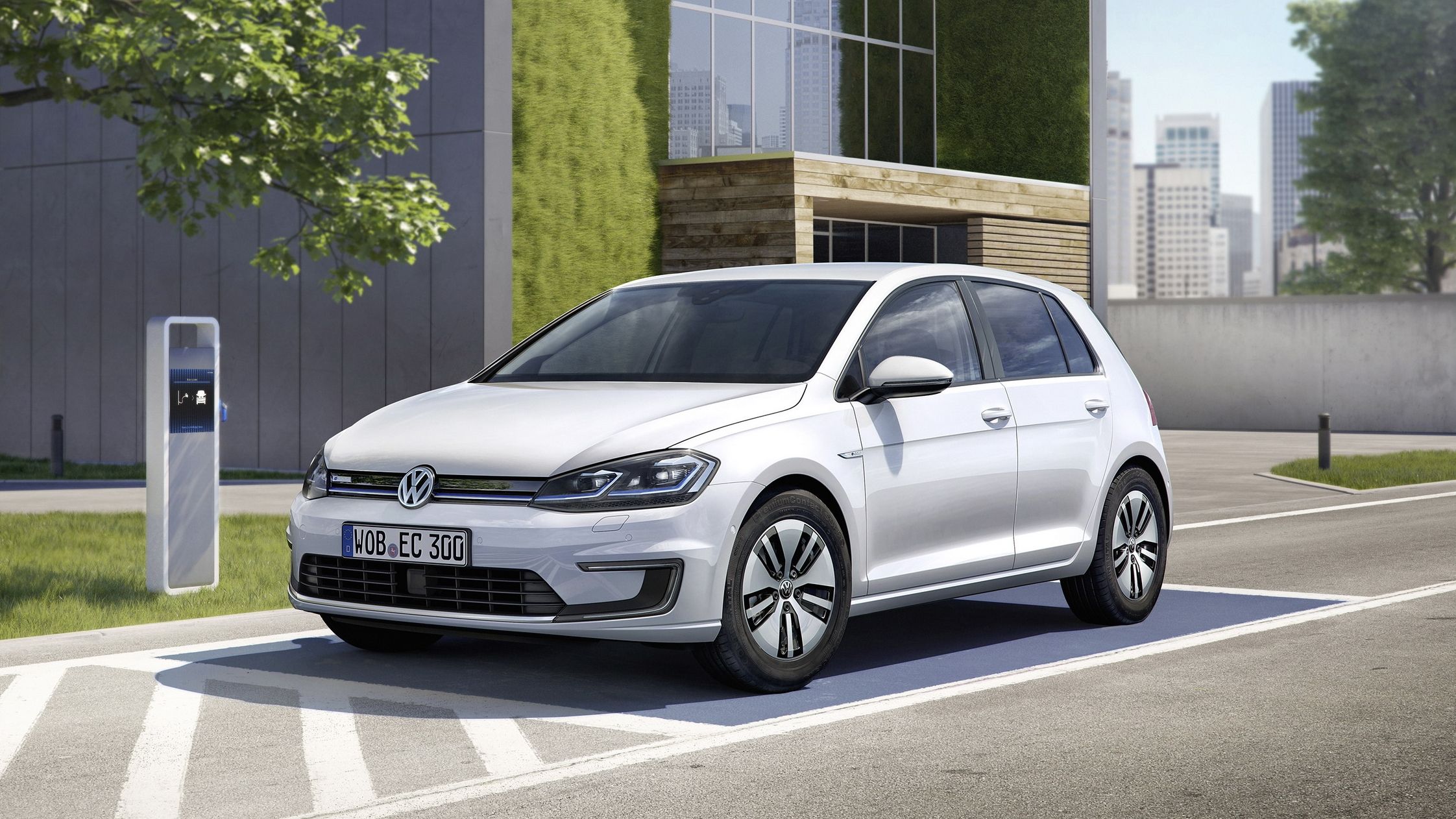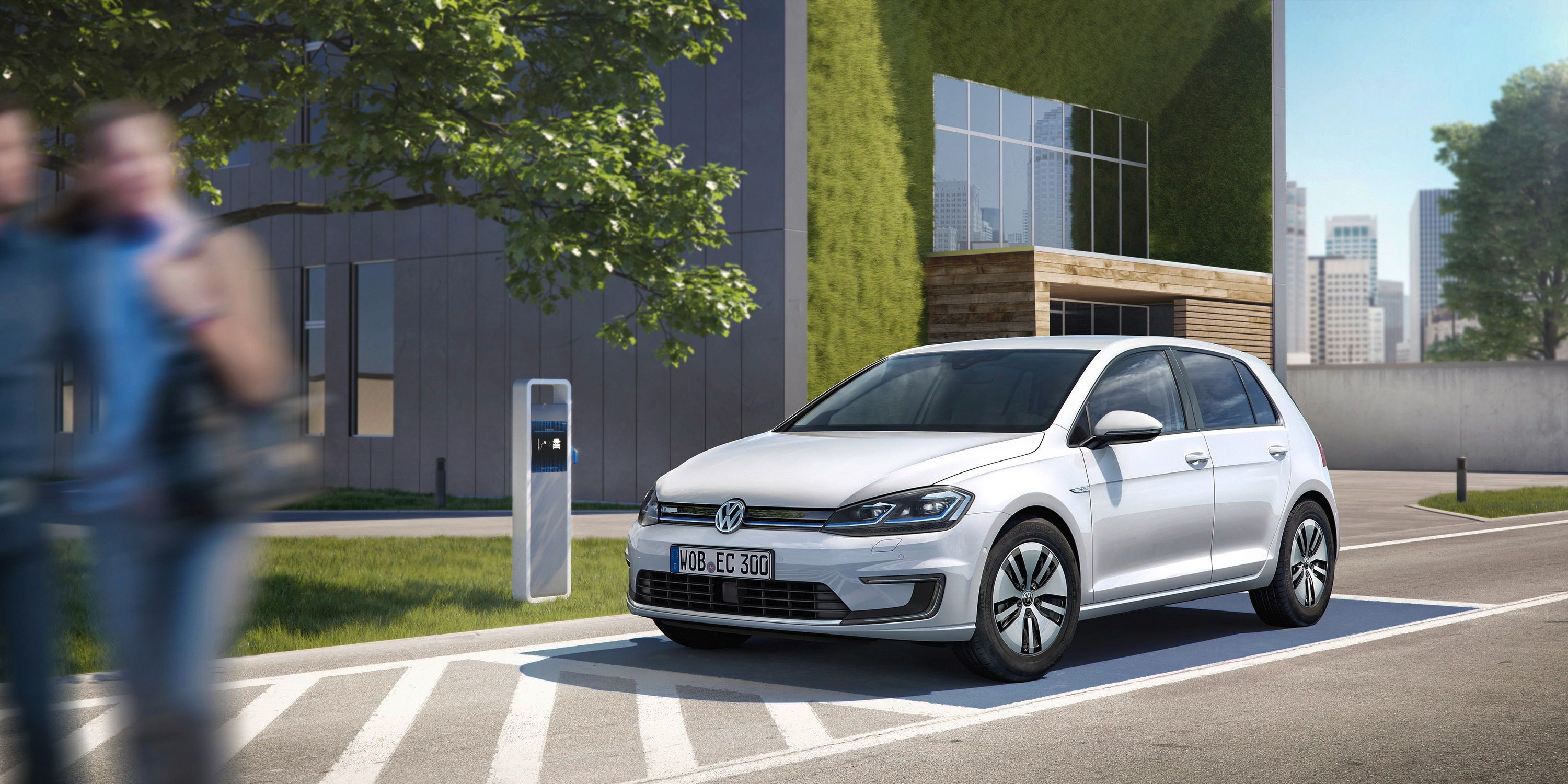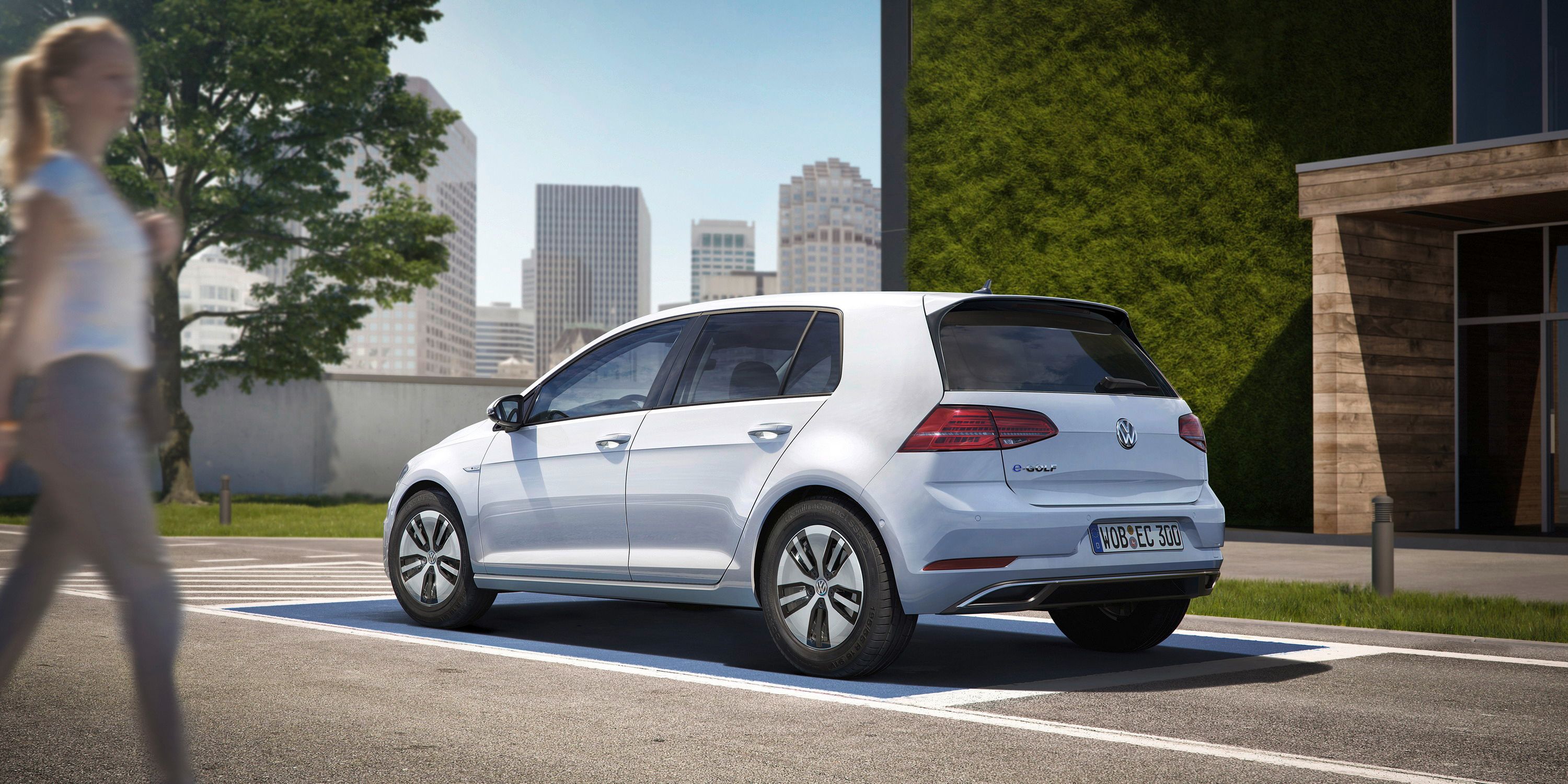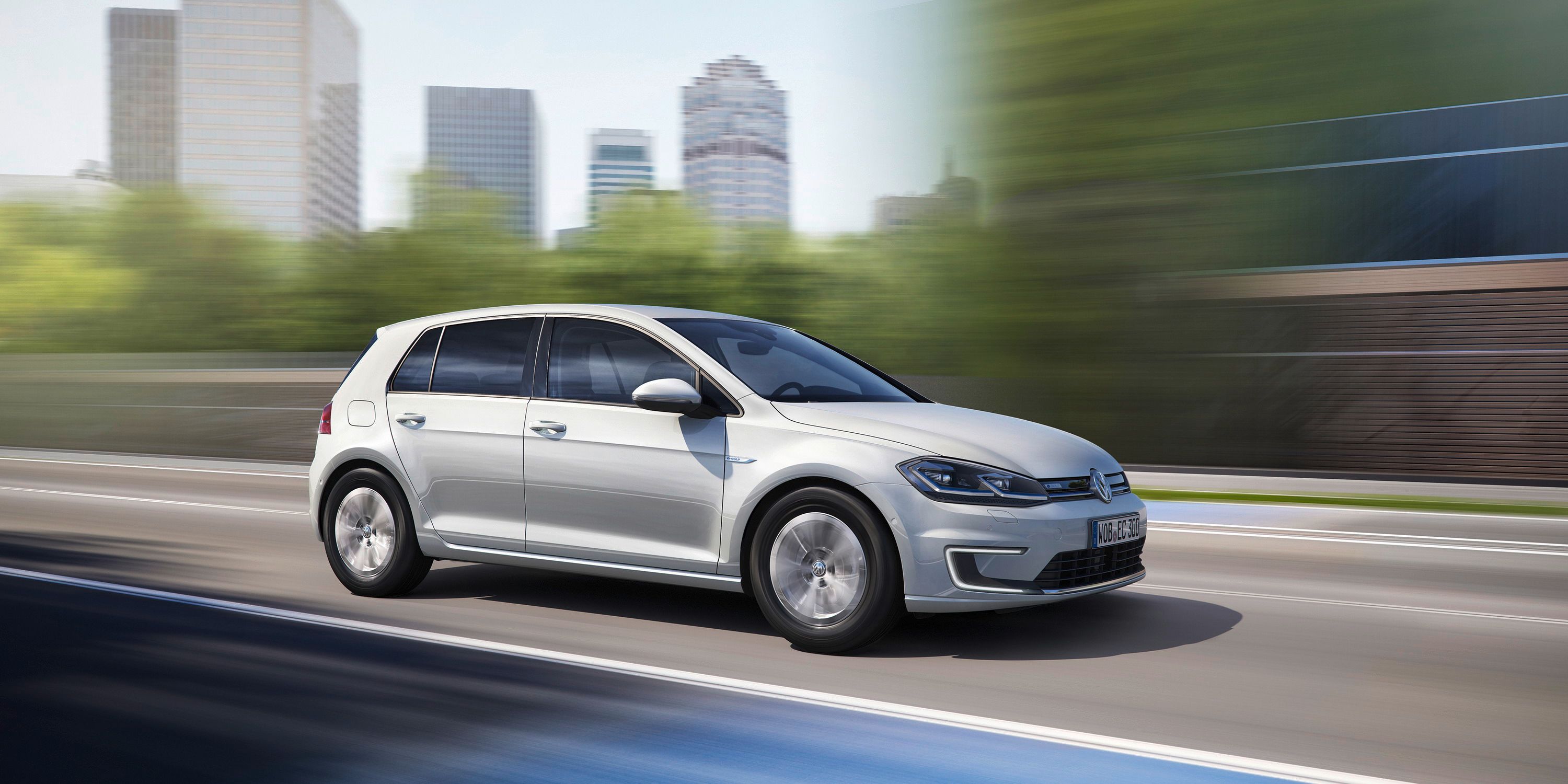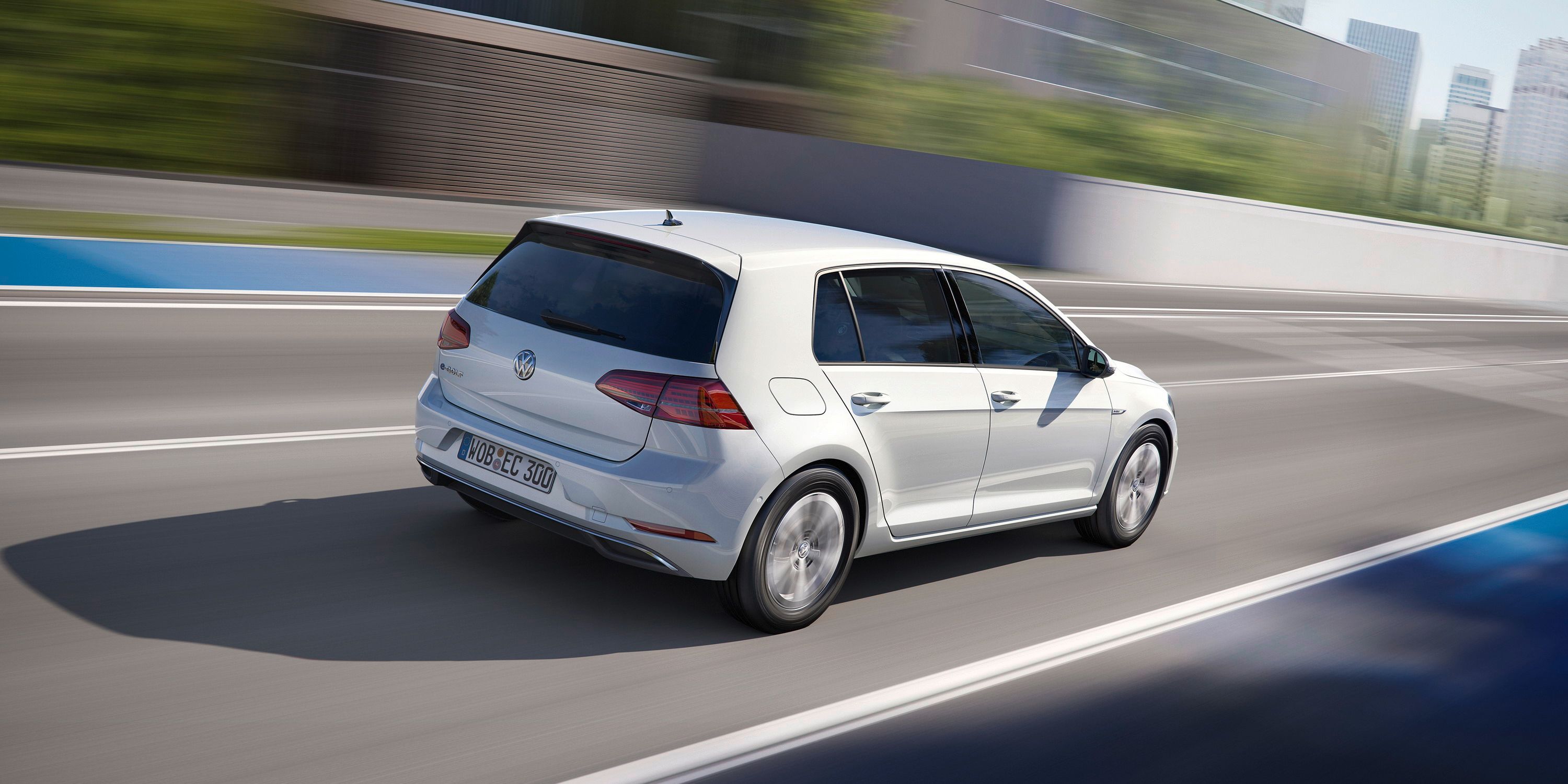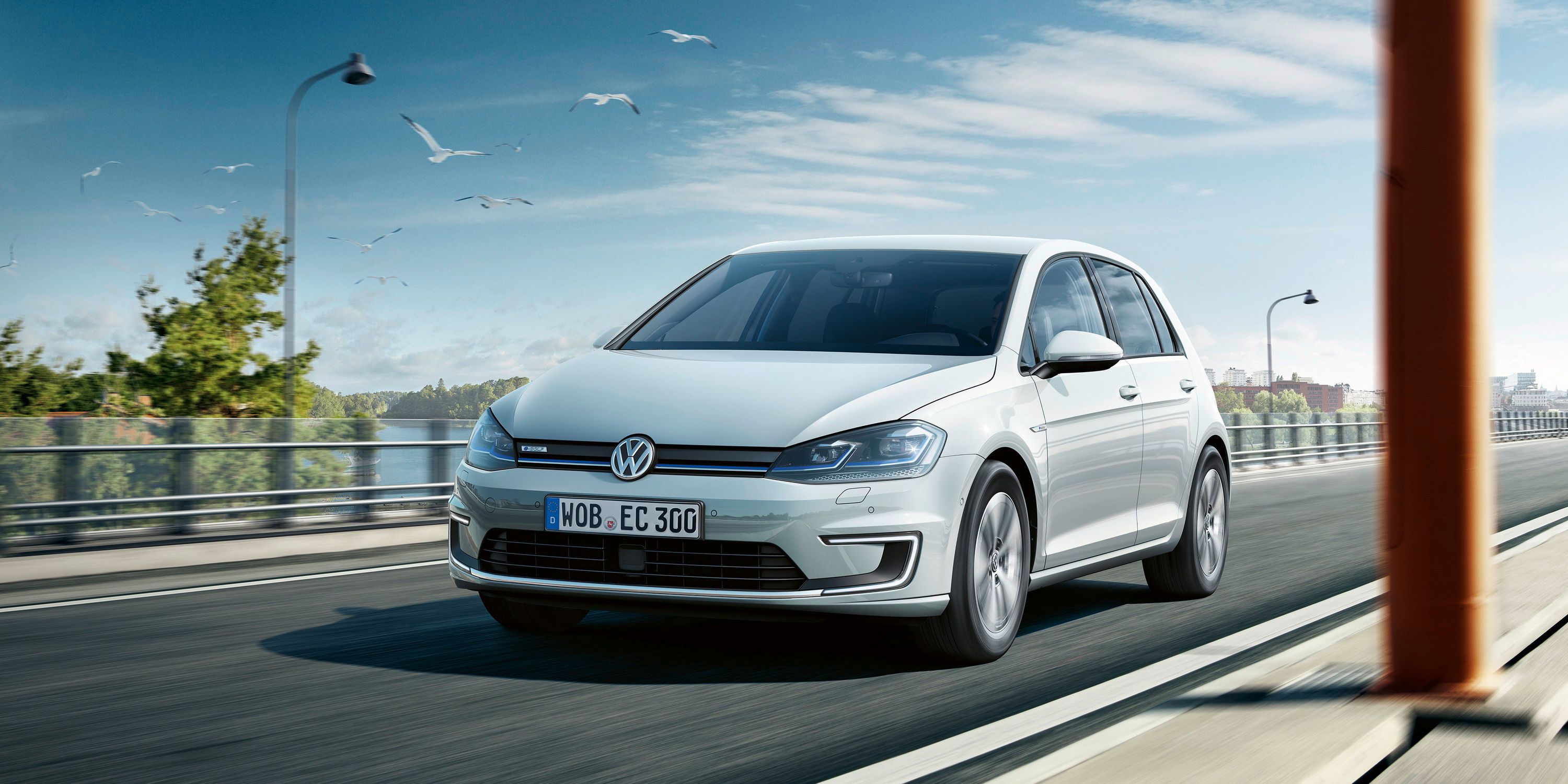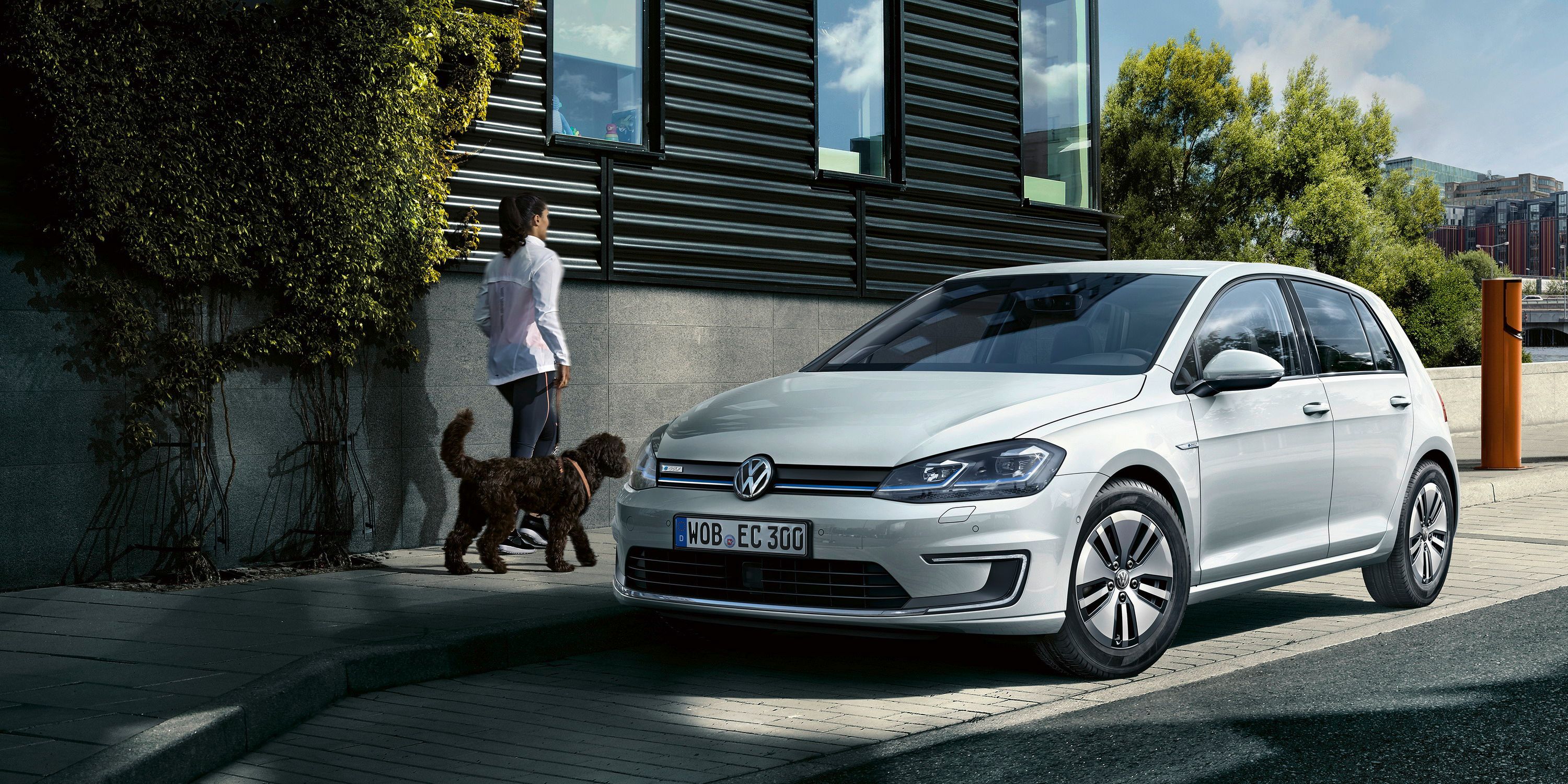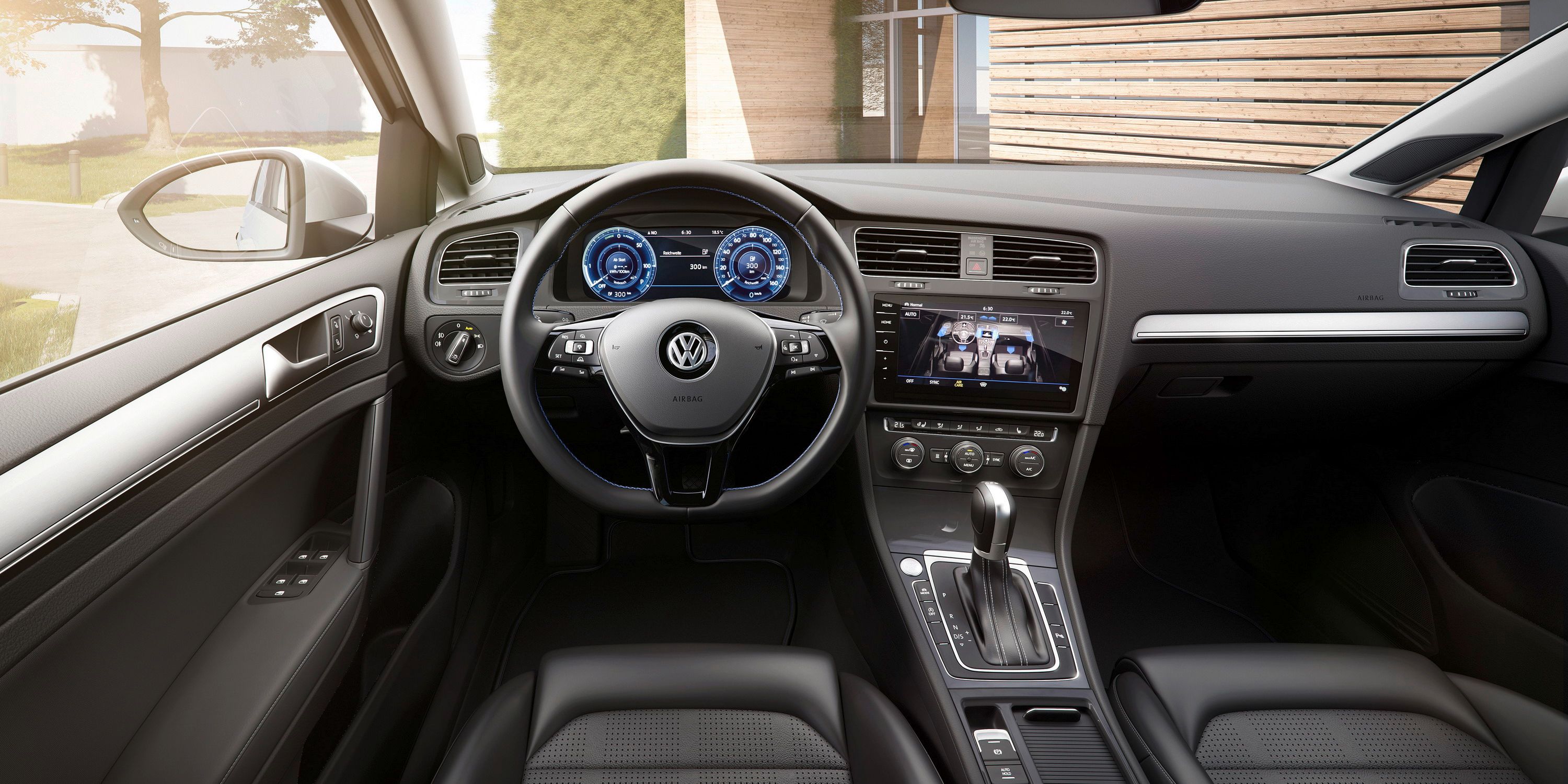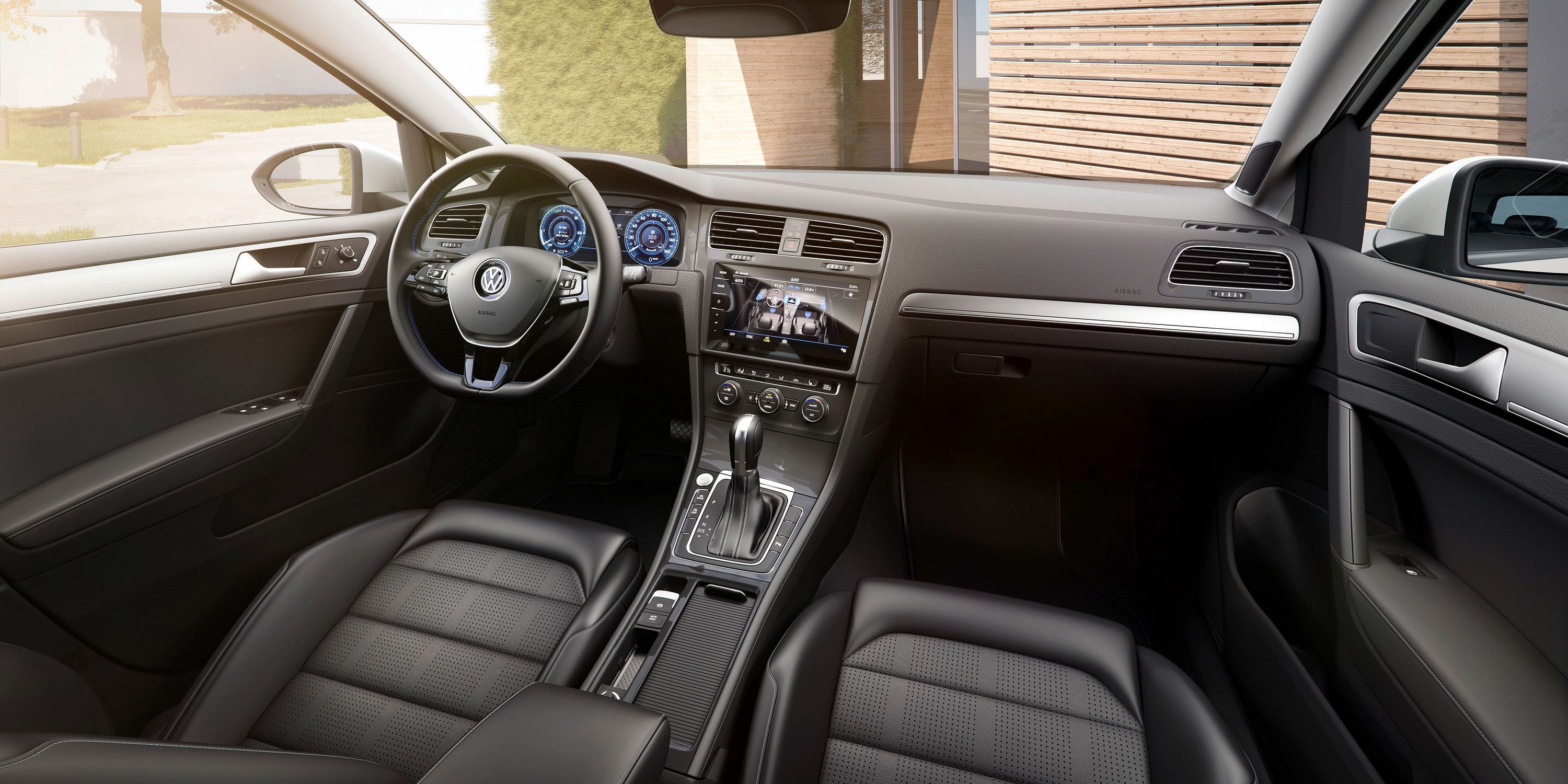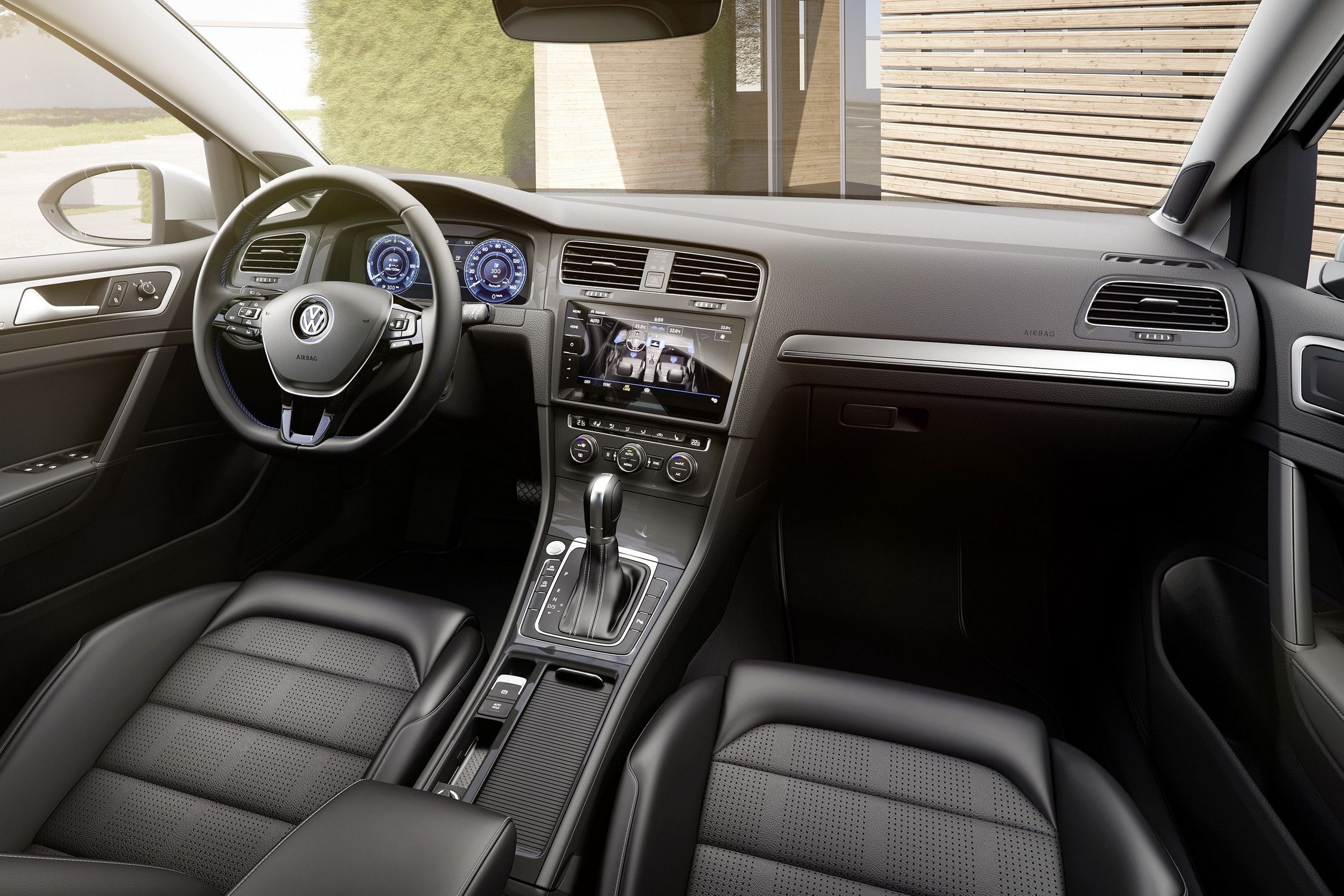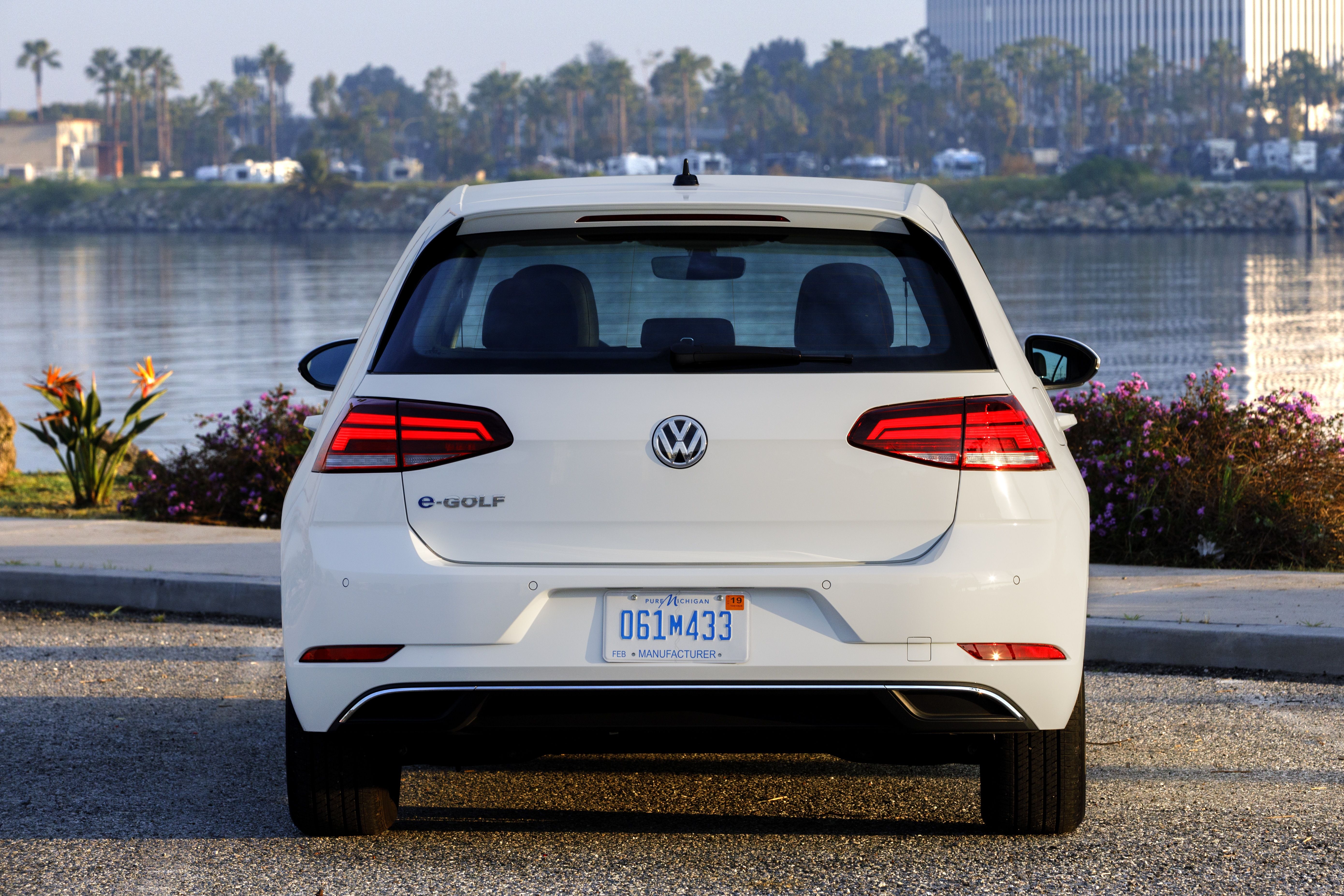Unveiled at the 2013 Frankfurt Motor Show, the e-Golf went on sale globally in the summer of 2014, about two years after the Golf Mk7 it is based on made its public debut. In the U.S., the e-Golf arrived in late 2014 as a 2015-model-year vehicle. Essentially a standard Golf with the gasoline engine swapped for an electric motor and a battery pack, the e-Golf crossed the pond to North America with 115 horsepower and 199 pound-feet of torque. The EPA rated the hatchback at 83 miles on a single charge, which put it on par with EVs like the Ford Focus Electric and Nissan Leaf. For 2017, the e-Golf received a comprehensive update that added new technology, a new battery, more power, and an extended range.
Unveiled only a few weeks after Volkswagen debuted the regular Golf range, including the performance GTi model and the GTE hybrid, the facelifted e-Golf benefits from the same upgrades as the standard hatchback. While exterior changes are minor, customers now have access to new technology and features, including the optional gesture control function that Volkswagen unveiled in 2015. The revised e-Golf offers better performance, with the tweaked motor and larger battery delivering more horsepower and torque. Also quicker and able to reach a higher top speed, the e-Golf comes with 50-percent more range than the outgoing model.
The new tech and powertrain puts the e-Golf above its traditional rivals, but it's not yet ready to go against the upcoming Chevrolet Bolt. Find out how it compares with its most important competitors in the review below.
Continue reading to learn more about the Volkswagen e-Golf
2017 Volkswagen e-Golf
- Make: Array
- Model: 2017 Volkswagen e-Golf
- [do not use] Vehicle Model: Array
Exterior
Just like the conventional and plug-in hybrid versions of the facelift Golf Mk7, there's not much to be said about he e-Golf as far as exterior updates go. A closer look at the body reveals identical add-ons compared to the GTE. There's a new blue strip at the bottom of the radiator grille that extends through the LED daytime running lights, which in turn are integrate into revised LED headlamps. The blue stripe is what separates the e-Golf from the standard and GTi models, which have chrome and red trim instead. The GTE hybrid also has a blue stripe, but the electric hatchback is recognizable thanks to the "e-Golf" badge on the grille. Down below, there's a reshaped bumper with a wider grille and redesigned foglamps.
The radar sensor for the Adaptive Cruise Control and Front Assist system was removed from the lower cooling air intake and repositioned behind the emblem in the radiator grille. Around back, the hatchback received new LED taillights, while everything else remained unchanged. If you're looking for features that set it apart from the standard Golf, be on the lookout for an "e-Golf" badge on the tailgate and missing exhaust pipes. Volkswagen didn't say whether the animated flowing indicators and the switch-over between the taillight and the brake light functions that are available for the more expensive trim levels will be offered on the e-Golf too, but it's a possibility.
COMPETING DESIGNS
The Golf's number one competitor in most markets is the Ford Focus. Available in both ST and RS versions, which rival the Golf GTi and R, the Focus has also available with an all-electric drivetrain since 2011. However, while the e-Golf is basically identical to its gasoline and diesel models, the Focus Electric (left) has plenty of features that set it apart from the conventional hatchback. And, that's not necessarily a good thing. Specifically, the Focus Electric appears to blend styling cues from the current models as well as cues from the pre-facelift hatchback. The grille is a tad different and a bit narrower, the engine hood doesn't have a bulge, the headlamps have a more rounded design, while the front bumper comes without side intakes, which makes the car look rather bland. I know it's an electric and that these vehicles aren't supposed to look sporty (especially if they aren't, which is the case with the Focus), but this car simply looks dated compared to the regular model. And this isn't good against the e-Golf either.
The second car on this list is the Nissan Leaf (right) and to be honest, it isn't doing better than the Focus Electric. Launched in 2010, the Leaf has yet to receive a design update and it looks like it will soldier on with the same bulbous styling in 2017 too. Granted, it's by no means ugly and it comes with the kind of cuteness you find in some Japanese kei cars, but it could sure use a restyling. If Nissan adds a V-motion grille, LED lights, and more angular styling cues based on its latest design language, the Leaf could become one of the better looking compact EVs. Until that happens, you'll have to settle for this six-year old design if you want a Leaf.
|
Nissan Leaf |
Ford Focus Electric |
Volkswagen e-Golf |
|
|
Wheelbase (inches) |
106.3 |
104.3 |
103.6 |
|
Overall Length (inches) |
175.0 |
172.9 |
168.1 |
|
Overall Width (inches) |
69.7 |
71.8 |
70.8 |
|
Overall Height (inches) |
61.0 |
58.2 |
57.1 |
Interior
The car's interior carries over unchanged as far as styling goes, save for new trim panels for the doors, dashboard, and center panels. The cabin also gained new seat covers and customizable ambient lighting, but changes stop here. Fortunately, Volkswagen did a more significant upgrade in the technology department, adding features that turn the e-Golf into the most modern compact EV on the market.
First, there are new touchscreens based on the Active Info Display system. New features include gesture control, which Volkswagen showcased last year and has already included in a few models. However, gesture control doesn't come standard, being offered only with the range-topping (and more expensive) "Discover Pro" infotainment system. The latter benefits from an update that includes a new-generation MIB display with larger screens ranging from 6.5 inches with "Composition Color" to 9.2 inches with "Discover Pro". Touch and voice-command are standard features.
The instrument cluster is also new, now fully digital and displayed on a 12.3-inch screen. It has different information profiles, each displaying data and graphics differently in certain areas. The revised e-Golf also comes with a new Media Control app, which is an infotainment interface for tablets and smartphones and can be used to control many of the functions of the infotainment system. To do so, however, you have to connect the devices to the “Discover Media” or “Discover Pro” infotainment system, meaning it's not available on all models.
The German brand also introduced the Security & Service package, which gives the driver immediate access to Automatic Accident Notification, Breakdown Call, and Service Scheduling. Breakdown Call allows the driver or passenger to use the infotainment system to contact the Volkswagen Emergency Call Center for assistance or medical attention, while the system sends the vehicle data and its location to the emergency services.
COMPETING FEATURES AND TECH
Although not as premium as the Golf, the Focus Electric's interior (left) isn't far off when it comes to fit, finish, and quality. The base model may come with cloth seats and two-way adjustable head restraints, but the more expensive trims get leather-wrapped, eight-way front seats. The Electric comes with four-way adjustable restraints as standard and the overall quality seems to be on par with the Golf. The plastic surfaces aren't rough, while the two-tone finishes and alloy trim are pleasing to the eye. Unlike the gas and diesel models, the Electric uses cloth fabric made with Repreve fiber produced from 100 percent recycled materials. It also features soy-based foam in the seat cushions and air cleaner assemblies made from plastic bottles, milk jugs and other post-consumer recycled materials, which makes the Focus Electric green beyond the drivetrain. On the tech side, it comes with a SmartGauge with EcoGuide, which includes customizable LCD display that provide information about driving habits, fuel efficiency, performance, and electric range. The navigation system with SiriusXM Traffic and Travel Link is optional, as is the ambient lighting, and the dual-zone automatic climate system. Needless to say, the Focus Electric lacks many of the features offered as standard in the e-Golf.
Although it's far from new, the Leaf's interior (right) is still fresh thanks to Nissan's clever design and the update it received for the 2016 model year. The layout is a lot simpler and cleaner than the competition, so you won't get that high-tech-like feeling you may have in the e-Golf. However, if you enjoy simplicity, this might be thing you need. On the flipside, there's loads of plastic inside the Leaf and most of it, especially on the center console and upper dashboard, doesn't look too good. But then again, Nissan didn't develop this little EV as a premium offering. The additional display atop the instrument cluster is a nice touch, while the upgraded infotainment system brings it up to date. The base model uses a five-inch display with Bluetooth connectivity, audio streaming, hands-free text messaging, and NissanConnect, which includes mobile apps for Facebook, Pandora, and iHeart Radio. Moving up the range, the SV and SL trims add a seven-inch display that supports multi-touch, voice recognition, navigation, SiriusXM satellite radio, and additional apps. The graphic interface of the display is also new, while the charging screen information is updated every 12 miles. Nothing fancy indeed, but it gets the job done.
|
Nissan Leaf |
Ford Focus Electric |
Volkswagen e-Golf |
|||
|
Nissan Leaf |
Ford Focus Electric |
Volkswagen e-Golf |
41.2/37.3 |
38.3/38 |
38.4/38.1 |
|
Headroom front/rear (inches) |
42.1/33.3 |
43.1/33.2 |
41.2/53.9 |
||
|
Legroom front/rear (inches) |
54.3/52.5 |
55.6/52.6 |
55.9/53.9 |
||
|
Shoulder room front/rear (inches) |
51.7/50.0 |
53.9/52.8 |
TBA |
Drivetrain
More important changes occured under the hood, where a more powerful electric motor replaced the original unit. Now rated at 134 horsepower and 214 pound-feet of maximum torque, the revised motor sends an extra 19 horsepower and 15 pound-feet to wheels, making the e-Golf faster than ever before. Specifically, the sprint from 0 to 60 mph is achieved in 9.6 seconds, more than a second faster than the outgoing model, while top speed increased from 86 to 93 mph.
The lithium-ion battery is brand-new and has an energy capacity of 35.8 kWh, up from 24.2. The range also increased from 83 to 124 miles, which translates to a 50-percent improvement over the original e-Golf. What’s more, the on-board 7.2 kW charger is now standard on both SE and SEL Premium trims, so both models can be charged to 100 percent in less than six hours at a traditional charging station. When equipped with DC Fast Charging, which is optional on SE and standard on SEL Premium, the battery can be charged to 80 percent within an hour at a DC fast charging station.
COMPETING PERFORMANCE
The Ford Focus might be a good option if you don't care much about the latest infotainment technology, but it sets the bar pretty low as far as performance goes. Although its electric motor isn't exactly weak at 123 horsepower and 181 pound-feet of twist, it needs more than 11 seconds to hit 60 mph and tops out at 84 mph. More importantly, its range is rated at only 76 miles, 48 below the e-Golf. There are rumors that Ford is planning to upgrade the car to 100 miles, but that's still significantly less than the German hatchback. Not to mention that a 100-mile range is by no means competitive in a market where cars like the Chevrolet Bolt and Tesla Model 3 promise to deliver more than 200 miles per charge.
The Nissan Leaf is doing a bit better, but it's also behind the e-Golf. Powered by an 80-kW AC synchronous electric motor that gets its juice from either a 24-kWh or 30 kWh lithium-ion battery, the Japanese EV comes with 107 horsepower and 187 pound-feet on tap. The maximum EPA-estimated range is 107 miles on a single charge, 23-mile improvement over the previous version. However, the upgrade is only available if you opt for the more expensive SV and SL trims, meaning the entry-level S model still uses the 24-kWh battery pack. A range increase is always good news, but much like Ford, Nissan needs to come up with an electric drivertrain capable of at least 150 in order to remain relevant.
|
Nissan Leaf |
Ford Focus Electric |
Volkswagen e-Golf |
|
|
Electric motor |
High-response 80 kW AC synchronous |
Permanent magnet electric traction motor |
Synchronous AC Permanent Magnet |
|
Battery |
30 kWh laminated lithium-ion (Li-ion), 192 cells |
33.5 kWh Lithium-ion, liquid cooled/heated |
35.8 kWh lithium-ion |
|
Horsepower |
107 HP |
143 HP |
134 HP |
|
Torque |
187 LB-FT |
184 LB-FT |
214 LB-FT |
|
Weight |
3,307 Lbs |
3,223 Lbs |
3,380 Lbs |
|
0 to 60 mph |
10.4 seconds |
11 seconds |
9.6 seconds |
|
Top Speed |
93 mph |
84 mph |
93 mph |
|
EPA range |
107 miles |
76 miles |
124 miles |
Safety
The facelift adds numerous driving assists and safety features to the e-Golf, including Traffic Jam Assist and new Pedestrian Monitoring for the Front Assist function with City Emergency Braking. The new safety package also includes Emergency Assist and a refined passenger protection system. Just like the outgoing model, the facelifted e-Golf comes with front airbags, driver’s knee airbag, side head and chest airbags, airbag cut-off switch, seat belt reminder, and ESC as standard. Overall, the German hatchback provides better safety than the Ford Focus Electric and Nissan Leaf.
What Others Are Saying
Although it's too early to talk about drive tests of the 2017 model, there are plenty of reviews about the outgoing model.
CAR AND DRIVER
Car and Driver praised the hatchback for the "novel packaging of the battery components that avoids reducing passenger space" and the numerous driver assisting options, but found out that the automaker's estimated range is difficult to reach, managing only 52 miles of EV range versus 83.
EDMUNDS
The folks over at Edmunds posted quite the positive revew, praising it for the "outstanding cabin materials and construction, superior ride and quietness, and just as much cargo capacity as other Golfs." The outlet also concluded that the "low center of gravity delivers impressive grip and handling" for an EV. On the other hand, it considered the e-Golf to have "less power and thus slower acceleration than some other electric vehicles."
What Car?
In What Car?'s review, the e-Golf earned four out of five stars. "The VW e-Golf has all the good points of a normal Golf but with greatly reduced running costs. Range still an issue though," is the outlet's conclusion. What Car? believes it is great to drive, well equipped, and spacious, but also describes it as pricey and complains about the range and the ride, which is "not as good as a normal Golf."
Prices
Pricing for the revised e-Golf is not yet available, the update shouldn't make the car much more expensive. With the current model priced from $28,995, the facelift will probably retail from a little more than $30,000. Pricing for the range-topping SEL Premium trim will probably jump from $35,595 to nearly $37,000.
COMPETING PRICES
The Volkswagen e-Golf's pricing is somewhat similar to its competition, despite the German EV offering more standard features and more state-of-the-art technology. For instance, the Focus Electric, which we've already established as a model that looks a bit dated and its mileage isn't very solid, starts from $29,120, which should be just $1K less than the revised e-Golf. It's a sticker I wouldn't pay to get weaker performance and less miles per charge, not too mention that the Focus is also far inferior to the Golf in terms of technology. Granted, the Focus can be had with incentives of up to $9,500, but the e-Golf could also be more affordable than its base MSRP. The Nissan Leaf is also at a disadvantage pricing-wise. Retailing from $30,680, the Leaf is actually more expensive than the current e-Golf and that's not likely to change compared to the revised model. Making matters worse, to benefit from the larger battery with more than 100 miles of range, you have to order the SV or SL models, meaning you need to spend at least $34,200. Not a very good deal to be honest.
|
Nissan Leaf S |
$30,680 |
|
Nissan leaf SV |
$34,200 |
|
Nissan Leaf SL |
$36,790 |
|
Ford Focus Electric |
$29,120 |
|
Volkswagen e-Golf |
$30,000 (est.) |
What Else You Can Buy
Kia Soul EV
Although technically a crossover, the Kia Soul EV is compact enough to be cross-shopped with the e-Golf. Heavily based on the familiar and boxy Soul hatchback, the EV stands out by means of a body-colored front grille and a few extra features usually found on electric cars. Unfortunately, much like the Focus Electric and Nissan Leaf, the Sould EV is far from impressive as far as range goes, being rated at only 93 miles by the EPA. Powered by a 27-kWh lithium-ion battery, the AC synchronous motor produces 109 horsepower and 210 pound-feet of torque. As of 2016, Kia sold more than 10,000 Soul EVs, with significantly more than half delivered in Europe. In the U.S., less than 2,000 units were delivered. The Soul EV retails from $31,950 in the U.S., which makes it the most expensive vehicle in this comparison.
Find out more about the Kia Soul EV here.
Chevrolet Bolt
Launched for the 2017 model year, the Bolt is the newest and most potent EV in the compact segment. The fresh exterior design is complemented by a modern cabin that includes loads of tech, such as Bluetooth connectivity, MyChevrolet App, 4G LTE Wi-Fi hotspot, connectivity for up to seven devices, Apple CarPlay and Android Auto. The instrument cluster is an eight-inch screen, while the 10.2-inch display gives access to the infotainment system. Powered by a battery produced by LG Chem, the Bolt's motor generates 200 horsepower and 266 pound-feet of torque, which enables the hatchback to hit 60 mph in am impressive seven seconds. Top speed is rated at 91 mph. More importantly, the EPA rating is 238 miles, which makes it the most efficient EV on the market as of November 2016. Pricing starts at $37,495, which is significantly more than the e-Golf, but the car is eligible for a tax credit of up to $7,500. Given the extra power and range, the Bolt is a better deal than the e-Golf even if it costs more.
Learn more about the Chevrolet Bolt here.
Conclusion
Although it didn't change much on the outside, the facelifted e-Golf gained quite a lot of updates in the tech department and under the hood. The previous model was already a better choice compared to the Ford Focus Electric, Nissan Leaf and Kia Soul EV, and the update just made it that much better. Also, the new technology and state-of-the-art features like gesture control put it on par with much newer vehicles and the recently launched Chevy Bolt. On the other hand, the 124-mile range isn't exactly competitive with the Chevy Bolt and Tesla Model 3 right around the corner, so the e-Golf will probably return slower sales over the next few years. For now, it's a good EV that gets the job done and gives customers plenty of new technology to enjoy, but Volkswagen needs to come up with an EV capable of at least 200 miles in order to remain competitive in this segment.

